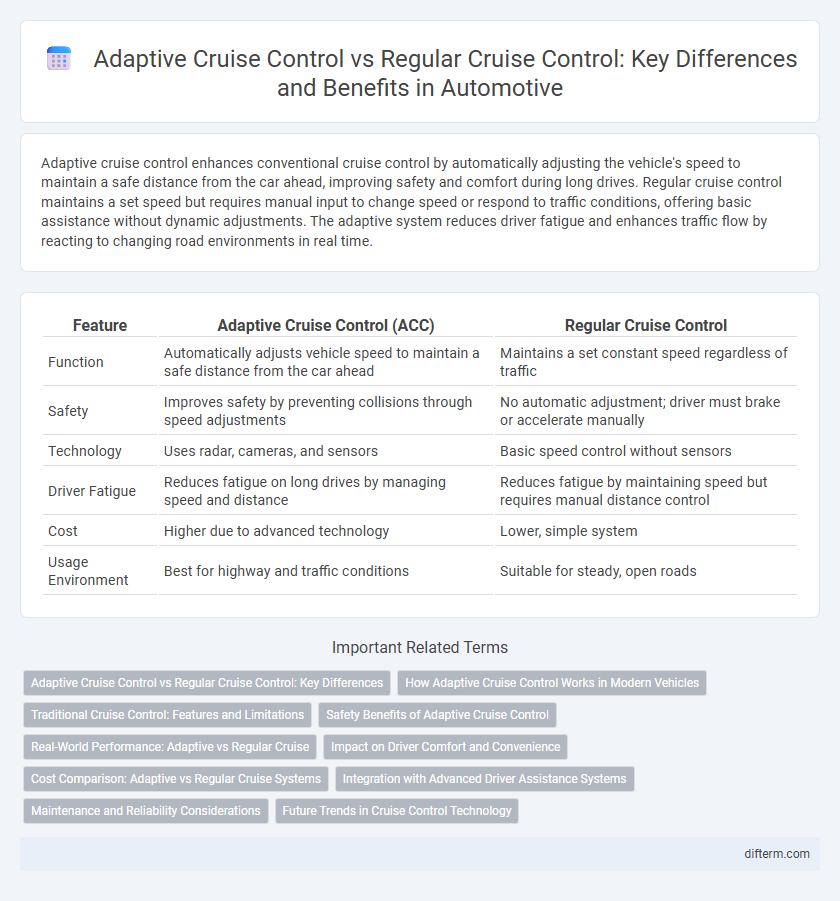Adaptive cruise control enhances conventional cruise control by automatically adjusting the vehicle's speed to maintain a safe distance from the car ahead, improving safety and comfort during long drives. Regular cruise control maintains a set speed but requires manual input to change speed or respond to traffic conditions, offering basic assistance without dynamic adjustments. The adaptive system reduces driver fatigue and enhances traffic flow by reacting to changing road environments in real time.
Table of Comparison
| Feature | Adaptive Cruise Control (ACC) | Regular Cruise Control |
|---|---|---|
| Function | Automatically adjusts vehicle speed to maintain a safe distance from the car ahead | Maintains a set constant speed regardless of traffic |
| Safety | Improves safety by preventing collisions through speed adjustments | No automatic adjustment; driver must brake or accelerate manually |
| Technology | Uses radar, cameras, and sensors | Basic speed control without sensors |
| Driver Fatigue | Reduces fatigue on long drives by managing speed and distance | Reduces fatigue by maintaining speed but requires manual distance control |
| Cost | Higher due to advanced technology | Lower, simple system |
| Usage Environment | Best for highway and traffic conditions | Suitable for steady, open roads |
Adaptive Cruise Control vs Regular Cruise Control: Key Differences
Adaptive Cruise Control (ACC) uses radar and sensors to maintain a safe following distance by automatically adjusting the vehicle's speed, while Regular Cruise Control maintains a fixed speed set by the driver without adjusting for traffic conditions. ACC enhances safety and convenience in varying traffic by detecting slower vehicles ahead and decelerating or accelerating accordingly. Regular Cruise Control is simpler and less expensive but lacks the dynamic responsiveness that ACC provides for modern driving environments.
How Adaptive Cruise Control Works in Modern Vehicles
Adaptive Cruise Control (ACC) in modern vehicles uses radar and camera sensors to monitor traffic conditions, automatically adjusting the car's speed to maintain a safe following distance from the vehicle ahead. Unlike regular cruise control, which maintains a constant speed regardless of traffic, ACC dynamically slows down or accelerates based on real-time data inputs. This technology enhances driving convenience and safety by reducing the need for manual speed adjustments in varying traffic conditions.
Traditional Cruise Control: Features and Limitations
Traditional cruise control maintains a constant vehicle speed set by the driver, improving comfort on long highway drives but lacks the ability to adjust speed based on traffic conditions. Its primary features include speed maintenance without driver input on the accelerator, but it cannot detect or respond to slowing vehicles ahead. Limitations of regular cruise control include its inefficiency in stop-and-go traffic and the absence of automatic braking or acceleration adjustments, which adaptive cruise control systems provide.
Safety Benefits of Adaptive Cruise Control
Adaptive Cruise Control (ACC) enhances vehicle safety by automatically adjusting speed to maintain a safe distance from the car ahead, reducing the risk of rear-end collisions. Unlike regular cruise control, ACC responds dynamically to changing traffic conditions, easing driver workload and minimizing fatigue. This intelligent system integrates radar and camera sensors, enabling proactive braking and acceleration for improved road safety.
Real-World Performance: Adaptive vs Regular Cruise
Adaptive cruise control uses radar and sensors to automatically adjust speed based on traffic conditions, enhancing safety and reducing driver fatigue during highway driving. Regular cruise control maintains a set speed without accounting for slower vehicles ahead, requiring manual braking or acceleration to adapt. Real-world performance of adaptive cruise control demonstrates improved traffic flow and collision avoidance compared to conventional systems.
Impact on Driver Comfort and Convenience
Adaptive cruise control enhances driver comfort by automatically adjusting vehicle speed to maintain a safe distance from traffic, reducing the need for constant acceleration and braking. Regular cruise control maintains a set speed without responding to changing road conditions, often requiring manual intervention in heavy traffic or hilly terrain. This advanced system significantly improves convenience during long drives and in stop-and-go traffic by minimizing driver fatigue and stress.
Cost Comparison: Adaptive vs Regular Cruise Systems
Adaptive cruise control systems typically cost between $500 and $1,200 more than regular cruise control due to advanced sensor technology and integration with vehicle safety systems. Regular cruise control, priced around $200 to $500, offers basic speed maintenance without automated braking or acceleration features. The higher initial investment in adaptive cruise control can lead to increased vehicle value and enhanced safety, potentially reducing long-term costs related to accidents and fuel efficiency.
Integration with Advanced Driver Assistance Systems
Adaptive cruise control (ACC) enhances regular cruise control by integrating radar and camera sensors to automatically adjust vehicle speed based on traffic conditions, improving safety and convenience. This system seamlessly connects with advanced driver assistance systems (ADAS) such as lane-keeping assist, collision avoidance, and automatic emergency braking for comprehensive driver support. The integration leverages vehicle-to-vehicle communication and real-time data processing to maintain optimal spacing and reduce driver fatigue on highways.
Maintenance and Reliability Considerations
Adaptive cruise control systems require specialized sensors and software that demand regular calibration and firmware updates to maintain accuracy, impacting overall maintenance complexity. In contrast, regular cruise control relies on simpler mechanical components, resulting in lower maintenance requirements and higher reliability over time. Evaluating long-term ownership costs should consider potential repairs linked to adaptive cruise technology's advanced electronics.
Future Trends in Cruise Control Technology
Adaptive cruise control leverages radar and camera sensors to maintain safe distances by automatically adjusting vehicle speed, unlike regular cruise control which maintains a fixed speed regardless of traffic conditions. Future trends in cruise control technology emphasize integration with vehicle-to-everything (V2X) communication, enabling real-time data exchange for enhanced traffic management and predictive speed adjustments. Advances in artificial intelligence will further optimize adaptive cruise systems by analyzing traffic patterns and driver behavior to improve safety and fuel efficiency.
adaptive cruise vs regular cruise Infographic

 difterm.com
difterm.com